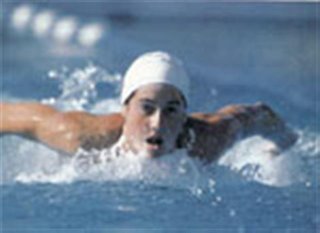
Amongst swimmers butterfly (fly) is the most highly regarded stroke – it’s the most beautiful and difficult of the strokes as well as one of the fastest. Swimmers will have our favourite (generally our most competitive) but if you asked them which stroke they would prefer being best in if they could choose I’d have to say 90% of us would pick fly. Because it's so damn wonderful when done right! The problem is the stroke requires healthy doses of both strength and technique. It also needs a certain minimum speed for the body to lift itself out of the water, otherwise the technique reverts to something much more like breaststroke (from which it developed). That means a novice trying to learn has to sprint to clear the surface up but, failing to possess the necessary technique to swim efficiently, is forced to rely entirely on his or her strength. Most exhausting and impossible to sustain for long. You see this happening all the time during public swims at your local pool. Someone starts to swim fly, manages to pull half a dozen or so strokes and then stops. They stop because they’ve destroyed themselves with all the effort of trying to lift themselves out of the water. Now consider what it would be like to swim fly for 100 meters, or God forbid, 200 meters (in masters swimming apparently the two races with the least participation are the 200 meter fly, and the 400 individual medley – a race which starts off with 100 meters fly and then graciously allows you to race the remaining three strokes with whatever you have left. Quelle surprise!) You need proper technique to swim fly, but you have to swim in order to learn the technique, a classic “chicken or the egg” dilemma.
The answer to this conundrum is coaching … professional coaching. First the proper double dolphin kick and arm stroke are taught and learned independently and only then integrated together using a series of drills. Once this is accomplished the complete stroke is then nursed along with the assistance of swim fins (to provide supplemental power) until, finally, the swimmer is able to swim a reasonable fly for short distances unassisted. From there it’s practice, correction, more practice, some more correction, and still more practice. What’s my butterfly like? Well as a child I didn’t race fly except in the individual medley, so it was never a priority for me. Practically speaking I can see now it didn’t make sense for my coaches to spend any real time teaching me fly until I started putting some meat on my bones and could actually compete in the stroke (the teaching technique for fly when I was learning was the "throw 'em in and let 'em sort it out" variety). So I developed a fly based almost entirely on my upper body strength with a single dolphin kick. And that’s was the stroke I brought with me when I returned to the pool. I told Canadian Sis about my attempts at fly and she couldn’t believe it, “you’re kicking backwards” she laughed. She was right for. Despite my best efforts I was kicking my single dolphin when my arms were in recovery and essentially driving myself under water. It was like swimming fly with the brakes on. With Coach Brad’s help I’m showing slow progress and can look forward to that day when, some months or years from now, everything will come together and I’ll finally learn fly … in a fashion. Until then I’ll struggle along with my drills such as that cursed Pablo drill, which makes me look like a hopelessly flailing spastic - clearly the great American flyer Pablo Morales was far more coordinated than I.
Picture of Mary T. Meagher, aka "Madame Butterfly", the most dominant butterflyer in swimming history
.jpg)
3 comments:
It was very interesting for me to read this post. Thanks for it. I like such themes and anything that is connected to this matter. I definitely want to read a bit more soon.
Anete Hakkinen
Pretty nice site you've got here. Thanks for it. I like such topics and anything connected to them. I would like to read a bit more on that blog soon.
Anete Hakkinen
Very Interesting!
Thank You!
Post a Comment